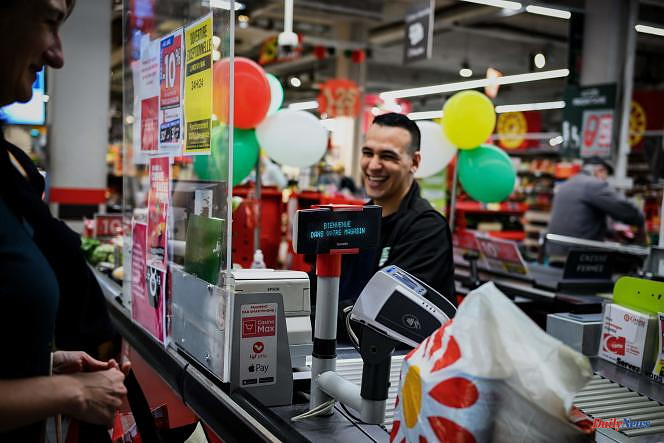A drop of 20% in one year for cereals, 15% for dairy products, 6% for meat... It is counter-intuitive for anyone who has seen the rise in prices in a supermarket, but world prices for basic food products fell by a total of 20% compared to April 2022, according to figures published Friday, May 5 by the United Nations Food and Agriculture Organization (FAO).
With the restoration of production and distribution chains, following the Covid-19 crisis, and the return to more moderate consumption after the dynamism of the recovery, the relationship between supply and demand has been rebalanced . And for nearly a year, the Black Sea Grain Initiative has allowed Ukraine to export wheat, sunflower and rapeseed again.
Yet food prices are not falling – on French shelves they continued to rise, by around 15% year on year in April. And, according to distributors, the trend is not likely to weaken: the head of System U, Dominique Schelcher, expects inflation over one year reaching "between 23% and 25% on food by the end June ".
To understand this paradox, let's go back up the chain from the shelves of supermarkets to the prices of raw materials on the financial markets, passing through the negotiations between manufacturers and distributors and the management of stocks by the latter.
As with gas, there is a gap between wholesale prices, generally set globally on the financial markets, and retail prices, which are more often national – and set, in France, through negotiations with large retailers. .
In fact, whether small farmers or agribusiness giants, producers are linked to distributors by fairly rigid contracts, negotiated once a year, in March. It could be twice this year: the Economy Ministry has urged players to return to the negotiating table before the summer so that the resulting price reductions "are returned to consumers".
These annual contracts protect distributors and consumers from variations, both upwards and downwards. They spare consumers a price spike when it occurs – for example, soft wheat, a variety used to make flour, had increased by 79% between January 2020 and July 2022; fortunately flour did not increase in the same proportions, with a less strong and more gradual increase of around 20% over the same period. But these contracts also have the effect of not allowing consumers to benefit immediately from the current decline. While world prices for vegetable oils have fallen by almost 48% between March 2022 and March 2023, label prices have increased in the same proportion.
After urging distributors to do their part in the fight against inflation, Bercy now insists with manufacturers on "the logic of reversibility to which they committed in April 2022". At the time, they were able to renegotiate during the year with distributors to pass on the increases in raw materials they suffered following the outbreak of the war in Ukraine. The EGalim laws, which opened up the possibility of re-discussing prices in the event of significant variations in commodity prices, would now make it possible to replay the match.
Manufacturers, on the other hand, consider that it is a little early to talk about a decline in prices when they are still subject to very heavy costs, being bound by contracts lasting several months, or even a year, with their suppliers of raw materials. , fertilizers, packaging, energy… Jean-Philippe André, president of the National Association of Food Industries, describes the dilemma as follows: “If you bought raw materials at a high price, and you have in your stocks for one, two or three months, you cannot accelerate the phenomenon of leaving your stocks”, by selling them off, in short. "That would be suicidal. »
Imagine, despite its reluctance, that the industry still agrees to discuss its prices again. A round of negotiations between agri-food sales representatives and distribution buyers lasts about three months. Then, if the discussion leads to price reductions, these will not apply immediately; they will spread out as distributors' stocks run out.
It is necessary to count "between two and three months of implementation, because the repercussion is done as and when the stocks are renewed on the shelves", confirms Jacques Creyssel, general delegate of the Federation of commerce and distribution, who represents signs. Concretely, if medium and large stores have built up significant reserves of certain products and/or buyers are becoming rarer, stocks at old prices will take longer to give way to new ones.
"The prices on the world markets are transmitted with delay to the rest of the production chain", explains Julien Pouget, head of the business cycle department at INSEE. In general, it takes two to three quarters to see the effects of a strong variation in raw materials on the labels, estimates the expert.
Admittedly, world commodity prices have fallen sharply in recent months, but, if we take the FAO index, they still remain 12% above their January 2021 levels. in the financial markets are only one part of the equation. In the formation of prices, producers must indeed take into account several elements, all moving, in a more or less predictable way: the price of packaging, transport, storage... and above all the costs of energy and labor. -work. In some sectors, such as market gardening, labor accounts for nearly half of the costs. However, the minimum wage has increased by 12% since 2021.
With regard to energy, there is indeed a decline in gas and electricity prices. But that doesn't necessarily mean that all companies have lower energy costs. Because, explains Julien Pouget, "it depends on their contract and when they had to renegotiate it when it expired. If it was at a fixed price over a contractual period, and it expired at the end of summer 2022, it had to be renegotiated under fairly unfavorable conditions, since the prices were very high. »
Among the incompressible and difficult to control expenses, for the majority of farms, the supply of inputs, seeds and fertilizers. However, the price of fertilizers – a large part of which is made with gas – has more than doubled in two years.
This explains half of the increase in the selling price on the farmers' side, calculated the General Inspectorate of Finance, which looked at the margins of the various links in the chain - the other half benefited farmers who have improved their income, among the lowest in France.












